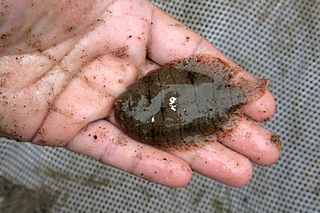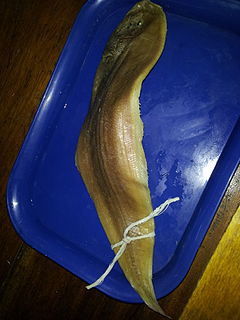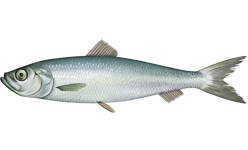
Mackerel is a common name applied to a number of different species of pelagic fish, mostly from the family Scombridae. They are found in both temperate and tropical seas, mostly living along the coast or offshore in the oceanic environment.

Herring are forage fish, mostly belonging to the family Clupeidae.

Carcharhiniformes, the ground sharks, with over 270 species, are the largest order of sharks. They include a number of common types, such as catsharks, swellsharks, and the sandbar shark.

The mullets or grey mullets are a family (Mugilidae) of ray-finned fish found worldwide in coastal temperate and tropical waters, and some species in fresh water. Mullets have served as an important source of food in Mediterranean Europe since Roman times. The family includes about 78 species in 20 genera.

The true soles are a family, Soleidae, of flatfishes. It includes saltwater and brackish water species in the East Atlantic, Indian Ocean, and West and Central Pacific Ocean. Freshwater species are found in Africa, southern Asia, New Guinea, and Australia.

The Gonostomatidae are a family of mesopelagic marine fish, commonly named bristlemouths, lightfishes, or anglemouths. It is a relatively small family, containing only eight known genera and 32 species. However, bristlemouths make up for their lack of diversity with numbers: Cyclothone, with 13 species, is thought to be the most abundant vertebrate genus in the world, numbering in the hundreds of trillions to quadrillions.

Pleuronectidae, also known as righteye flounders, are a family of flounders. They are called "righteye flounders" because most species lie on the sea bottom on their left sides, with both eyes on their right sides. The Paralichthyidae are the opposite, with their eyes on the left side. A small number of species in Pleuronectidae can also have their eyes on the left side, notably the members of the genus Platichthys.

The hogchoker is a small flatfish found along the Atlantic coast of North America, ranging from Massachusetts and Florida to Panama. They prefer brackish water, and are abundant in many bays and estuaries north of the Carolinas. It is a member of the American sole family Achiridae. They are usually brown to dark brown in color, and lighter on their "blind side". The overall body color is often broken by a series of spots and thin stripes, which can be lighter or darker than the main body color. The fins and tail have fringed edges helping hide the fish from its prey. They mainly feed on small aquatic insects and invertebrates. They are regarded as "trash fish" by recreational fishermen and were fed to pigs but they have rather bony bodies which were sometimes difficult for the pigs to swallow, hence the vernacular name.

Demersal fish, also known as groundfish, live and feed on or near the bottom of seas or lakes. They occupy the sea floors and lake beds, which usually consist of mud, sand, gravel or rocks. In coastal waters they are found on or near the continental shelf, and in deep waters they are found on or near the continental slope or along the continental rise. They are not generally found in the deepest waters, such as abyssal depths or on the abyssal plain, but they can be found around seamounts and islands. The word demersal comes from the Latin demergere, which means to sink.

Echinorhinus is the only extant genus in the family Echinorhinidae.

Tonguefishes are flatfish in the family Cynoglossidae. They are distinguished by the presence of a long hook on the snout overhanging the mouth, and the absence of pectoral fins. Their eyes are both on the left side of their bodies, which also lack a pelvic fin. This family has three genera with a total of more than 140 species. The largest reaches a length of 66 cm (26 in), though most species only reach half that size or less. They are found in tropical and subtropical oceans, mainly in shallow waters and estuaries, though some species are found in deep sea floors, and even a few in rivers.

Lucania is a genus of North American ray-finned killifishes in the family Fundulidae. The genus can be found in northeastern Mexico and the southeastern and eastern parts of the United States, with L. parva ranging as far north as Massachusetts. They are mostly found in fresh water, although L. parva also is frequent in coastal brackish water. They are sometimes held in aquariums.

Fish are very diverse animals and can be categorised in many ways. This article is an overview of some of ways in which fish are categorised. Although most fish species have probably been discovered and described, about 250 new ones are still discovered every year. According to FishBase, 34,300 species of fish had been described as of September 2020. That is more than the combined total of all other vertebrate species: mammals, amphibians, reptiles and birds.

Clupea is genus of planktivorous bony fish belonging to the family Clupeidae, commonly known as herrings. They are found in the shallow, temperate waters of the North Pacific and the North Atlantic oceans, including the Baltic Sea. Three species of Clupea are recognized. The main taxa, the Atlantic herring and the Pacific herring may each be divided into subspecies. Herrings are forage fish moving in vast schools, coming in spring to the shores of Europe and America, where they form important commercial fisheries.

Achirus is a genus of American soles native to tropical and subtropical parts of the Americas. They are mainly found in coastal areas, including salt and brackish water, but some species are found in fresh water.

Trinectes is a genus of American soles native to the Americas. Most species are coastal, occurring in both salt and brackish water, but several may enter fresh water and one, T. hubbsbollinger, is restricted to rivers. They are fairly small, with the largest species only reaching 25 cm (9.8 in) in length.
Achirus novoae is a species of sole in the family Achiridae. It was described by Fernando Cervigón in 1982. It inhabits the Orinoco River. It reaches a maximum length of 10.6 cm (4.2 in).
Achirus zebrinus is a species of sole in the family Achiridae. It was described by Howard Walton Clark in 1936. It is found in the southeastern Pacific.
Catathyridium garmani is a species of sole in the family Achiridae. It was described by David Starr Jordan in 1889, originally under the genus Achirus. It is known from Argentina, Brazil, and Uruguay. It reaches a maximum length of 17 cm (6.7 in).
Catathyridium lorentzii is a species of sole in the family Achiridae. It was described by Hendrik Weyenbergh in 1877, originally under the genus Achirus. It inhabits the Uruguay and Paraguay rivers. It reaches a maximum length of 5.4 cm (2.1 in).



















